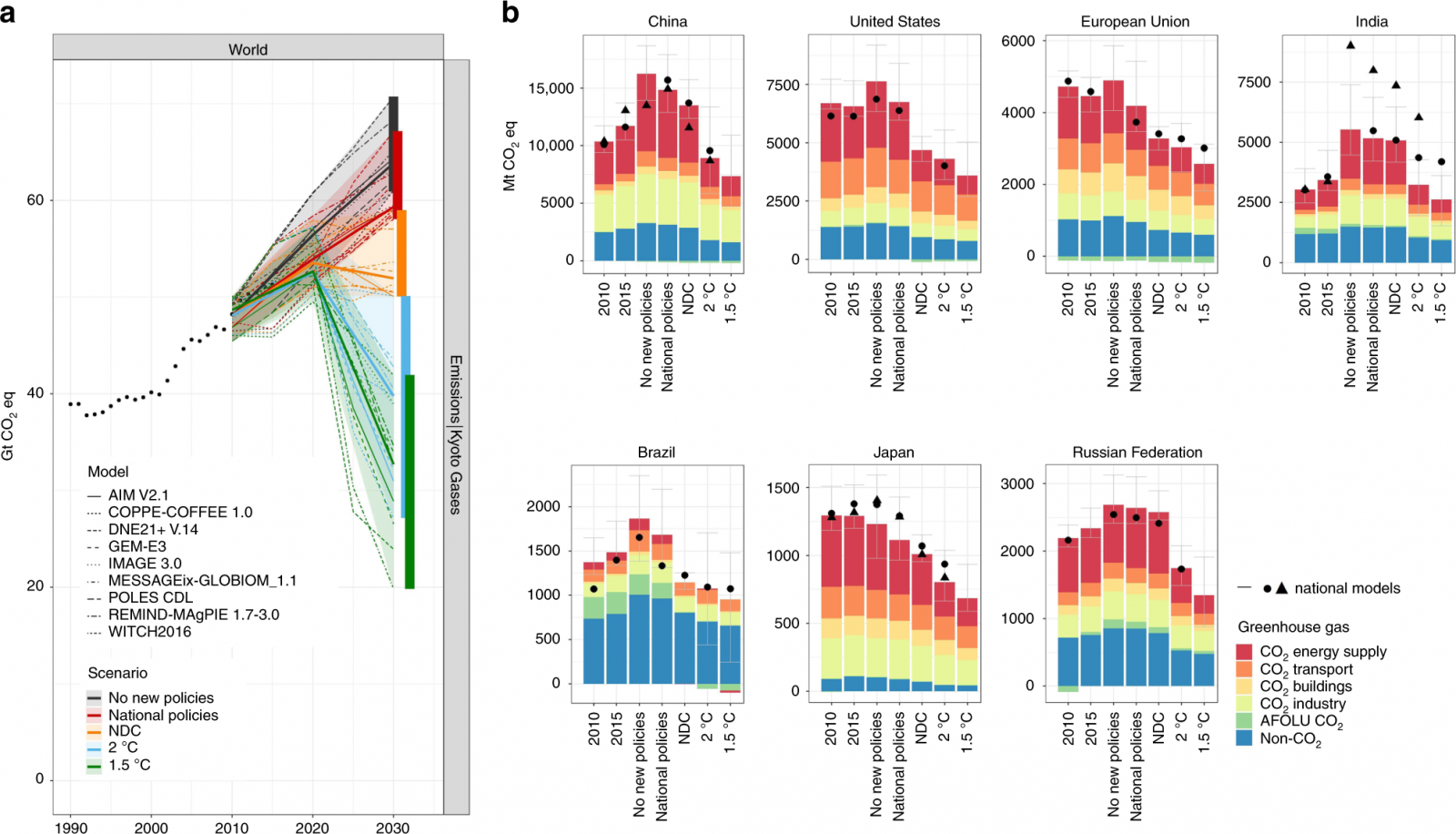Five years after the Paris Agreement: Large gap between promises and current implementation
Publication in Nature Communications
Achieving the overall goals of the Paris Agreement will require a deep reduction in global greenhouse gas emissions, ideally by around 40%–50% by 2030. An international study involving modelling teams from around the world has developed scenarios to take stock of current climate actions on national levels and to compare them against the overall objective. The study was coordinated by researchers from Utrecht University and PBL Netherlands Environmental Assessment Agency.
The study shows that the current national implementation of climate policies is still insufficient to achieve the overall Paris goals and would lead to around 5.5% reduction in emissions by 2030. This also still falls significantly short of the pledged reductions as documented in the nationally determined contributions (NDCs), which, if implemented, would lead to a reduction of around 17%. A significant increase in both ambition and implementation is thus needed to achieve the Paris goals. These findings are a contribution to the global evaluation of the Paris Agreement, held during the next three years.
Researchers from institutes around the world, including Mark Roelfsema, Prof Detlef van Vuuren, Heleen van Soest, and Dr Mathijs Harmsen from Utrecht University, collaborated in a unique multi-model study to assess the impact of current climate policies. The study focuses on emission trends in seven countries and regions jointly responsible for the majority of global greenhouse gas emissions: Brazil, China, the European Union, India, Japan, Russia, and the United States.

Analysis of climate policy to implement the Paris Agreement
The aim of the Paris Agreement is to keep global temperature rise this century to well below 2 °C above pre-industrial levels and to pursue efforts to limit the temperature increase even further to 1.5 °C. This goal has been formulated at the global level, but achieving it critically depends on the national implementation of climate policies. To this end, countries have pledged national contributions (nationally determined contributions, NDCs) and implemented domestic policies to achieve them. Before the postponed UN climate conference (COP26) next year, countries are expected to update their pledged national contributions. Therefore, insights into the impact of current national policy are essential. To this end, the impact of this domestic policy, over the period up to 2030, has been analysed using nine climate policy models from various institutes around the world.

Impact of currently implemented policies
The scenario analysis performed by the models used in the study shows that in order to meet the global target of the climate agreement in a cost-optimal way, a 40%–50% reduction in global emissions is required. In order to assess the impact of implemented policies, the researchers inventoried the most important policies implemented in G20 countries and regions, from which they analysed seven large countries and regions in more detail. They found that the impact of the G20 policies would reduce greenhouse gas emissions by 2.5 to 5.0 gigatons of greenhouse gas emissions by 2030 or 4%–8%, compared to a situation where no climate policies and targets would have been implemented.
The actual reductions fall significantly short of those pledged in the NDCs. If implemented, those policies would lead to an additional reduction of about 5 to 10 gigatons of greenhouse gas emissions, equalling an emission reduction of about 17% by 2030, compared against a scenario without emission reductions.

Although the study shows that policies are indeed being implemented, it also identifies a large gap between the Paris goal and countries' pledged contribution, and an even larger gap with the actual implemented policies. A delay in action would either lead to additional costs or failure to achieve the Paris goal. The gap by 2030 is estimated to be around 22–28 gigatons of CO2 equivalents.
Trends in 7 large countries and regions
The study identifies a large gap between the impact of implemented climate policies and the reductions consistent with the overall goal of the Paris Agreement in all countries. The underlying cause, either an ambition or an implementation gap, varies between countries. In order to achieve the targets, all countries should accelerate the implementation of policies regarding renewable technologies and energy efficiency improvements.
In order to achieve the Paris Agreement, all countries should accelerate the implementation of policies regarding renewable technologies and energy efficiency improvements.
Results and policy database publicly available
The overview of the most important policies in the various countries forms part of the so-called climate policy database developed as part of the study. Researchers can still contribute to this database by adding new information on current policies. The main results from the study are presented via The Global Stocktake tool.
Publication
Mark Roelfsema*, Heleen L. van Soest*, Mathijs Harmsen*, Detlef P. van Vuuren*, et al.
Taking stock of national climate policies to evaluate implementation of the Paris Agreement
Nature Communications, 2020
* = from Utrecht University

